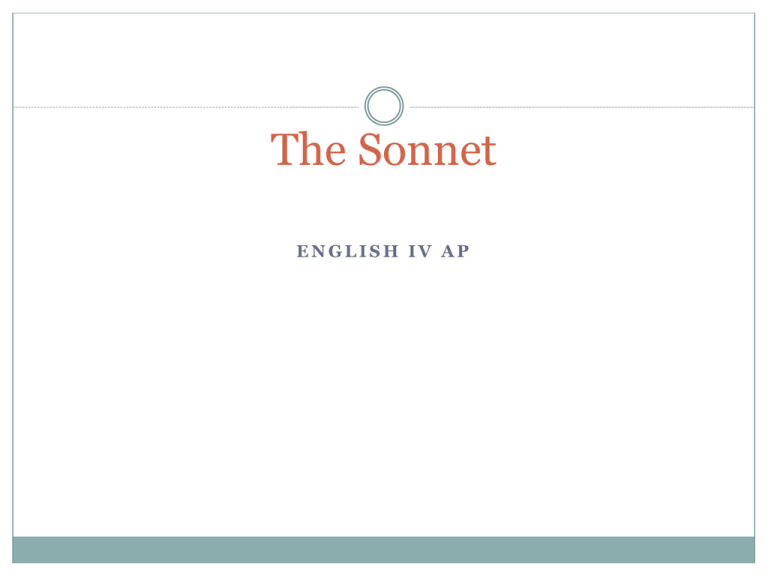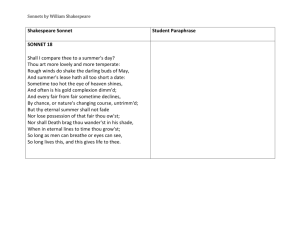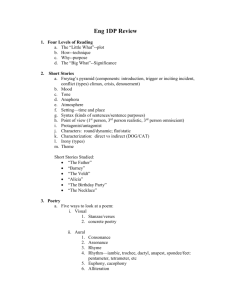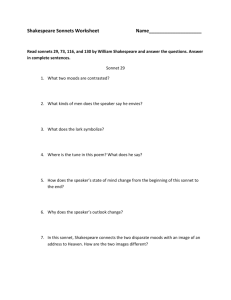Notes on the Sonnet
advertisement

The Sonnet ENGLISH IV AP Do Now: September 30th COMPLETE THE GRAMMAR WORKSHEET 1-15 I WILL CALL YOU UP IN ALPHA ORDER TO SUBMIT YOUR ESSAY. BE READY TO TURN IN YOUR BOOKS. The Sonnet 14 lines in length. Originated in Italy, made famous in 16th century England. Sonnet means “little song” or “little sound.” 3 types: Petrarchan, Spencerian, Shakespearean. Chief topic is love (often for one who is unattainable) Poets also express the idea of immortality through verse. Elizabethans loved the structure, did not see it as restrictive….allowed for creative expression The Shakespearean Sonnet: Form Shakespeare wrote 154 sonnets; they were published in 1609 (they represent a more than ten year process of writing) Notice how his poems reflect an awareness of mortality. His poems deal with the issue of “being” after death, the eternal life. written in iambic pentameter Unstressed syllable followed by a stressed syllable The rhyme scheme in a Shakespearean sonnet is a-b-a-b, c-dc-d, e-f-e-f, g-g; the last two lines are a rhyming couplet. Shakespeare is one of the best known sonneteers. (wrote 154 sonnets) Composed of 3 quatrains (4 lines) and 1 rhyming couplet Presents the problem/issue in first 12 lines, resolution or fresh look at the theme in the last two lines. Things to keep in mind…. Although written in first person, the poems do not provide a reliable account of Shakespeare’s life. They are not really autobiographical, though personal experiences may be reflected within their lines. They do not follow any clearly chronological pattern. The first 126 appear to address an aristocratic, fair young man. The next 26 refer to a dark-haired, somewhat promiscuous woman. The final 2 sonnets address Cupid He addresses conventional sonnet topics—love and beauty, and the related motifs of time and mutability. A few conclusions… The poems addressed to the young man and dark- haired lady may be literary inventions (characters). The sonnets do not present a narrative. We can make connections between them, but do not assume their “stories” are the same. Few of the sonnets are dramatic—they are lyric meditations on love Almost all of the sonnets follow the standard English or Shakespearean sonnet form Fourteen lines of iambic pentameter verse Seven rhymes arranged as three quatrains and a closing couplet The Petrarchan (Italian) Sonnet: Form The typical Italian sonnet structure included two parts that together formed an "argument.” First, the octave—8 lines ( or two quatrains--4lines each), forms the "proposition," which describes a "problem," followed by a sestet—6 lines (two tercets--3 lines), which proposes a resolution. The rhyme scheme is abba, abba (octave), while the sestet is built on two or three different rhymes. Typically, the ninth line creates what is called the "turn," or volta, which signals the move from proposition to resolution. In Shakespeare’s sonnets, this “turn” typically occurs in the couplet, usually summarizing the poem or offering a fresh look at the theme. Even in sonnets that don't strictly follow the problem/resolution structure, the ninth line still often marks a "turn" by signaling a change in the tone, mood, or stance of the poem The Focus Most of the sonnets focus on the topic of love— particularly an unattainable love. Shakespeare’s sonnets do not express a single philosophy of love. The sonnets reflect on feelings and situations related to love. Sonnet 116 has been called the marriage poem It states the true love lasts for all time It is a grand generalization, rare for Shakespeare, about love It can easily be applied to situations of love, marriage, and jealousy found in Shakespeare’s plays. Reminders. . . Do not assume that the speaker and the poet are the same person ( general rule of poetry). Still, what can we infer about the poet based on the content of the poem? Consider the “message” of the poem What literary devices help to convey that meaning? Annotate, annotate, annotate. . . . How do you think the poet would divide the poem? Label each sonnet. Is it Shakespearean or Petrarchan? How do you know? How do these poems address the ability to triumph over the laws of nature? (death, mortality, etc)






